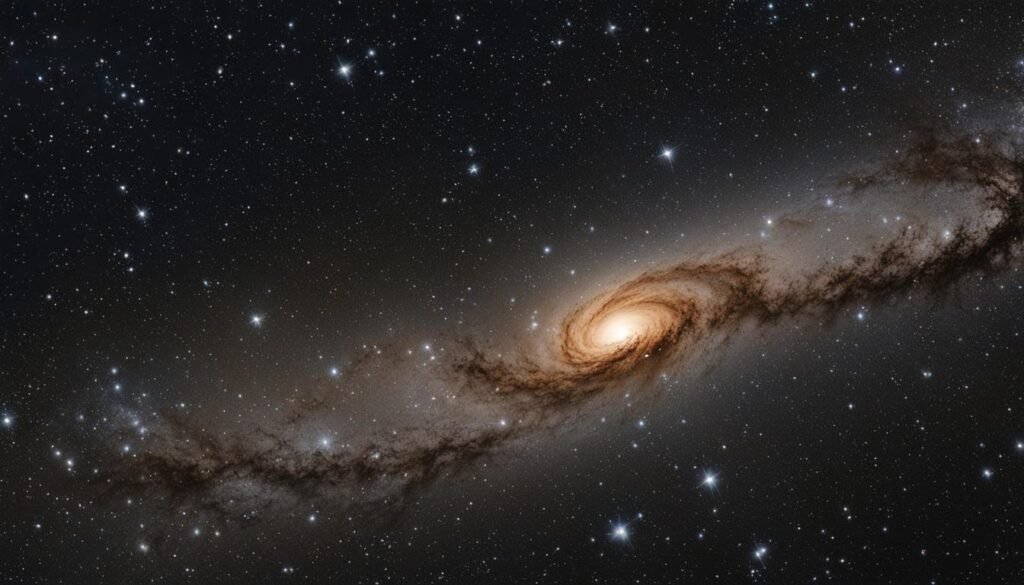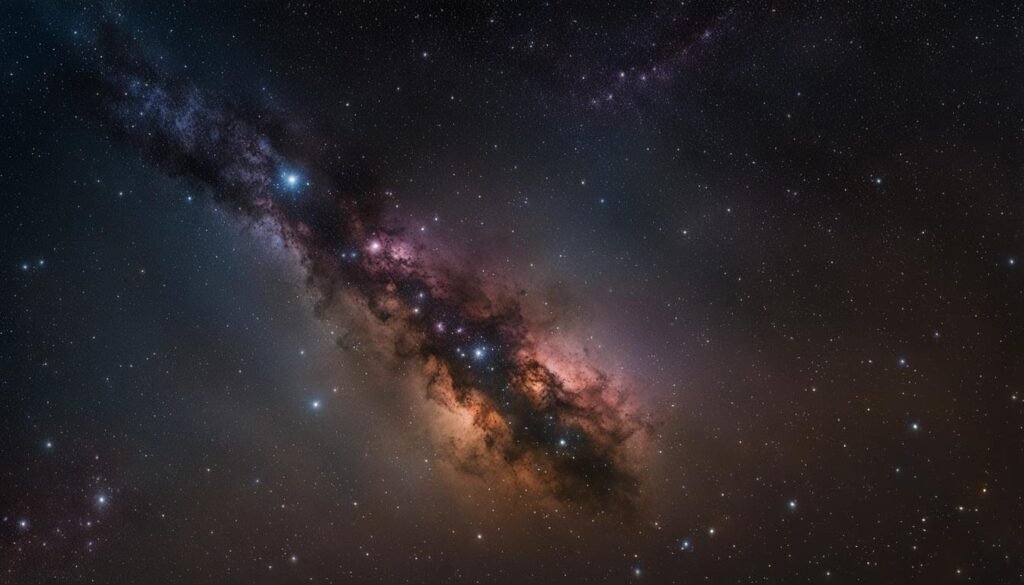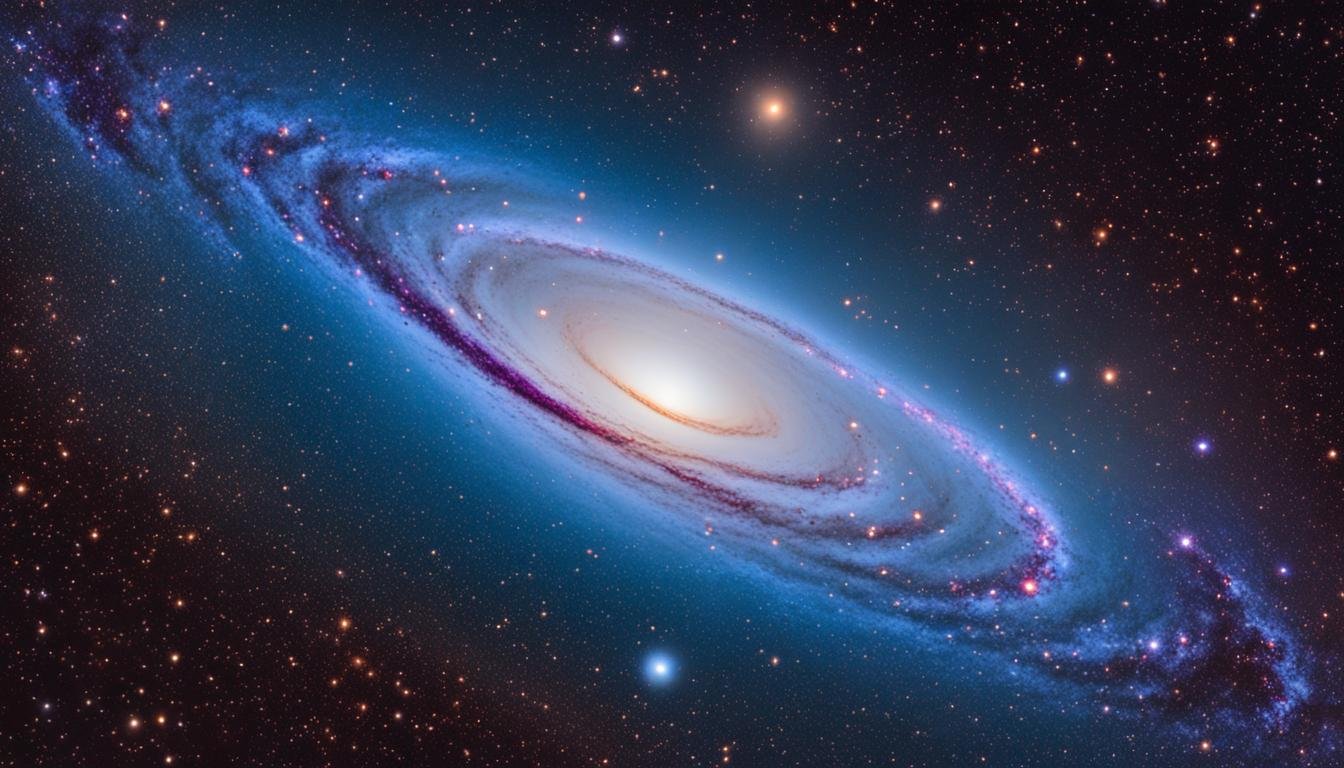Welcome to our exploration of Messier 54 (M54), a captivating globular cluster nestled within the constellation Sagittarius. In this article, we will delve into the location, classification, notable features, observability, and other intriguing aspects of Messier 54. Prepare to immerse yourself in the wonders of this extragalactic treasure.
Key Takeaways:
- Messier 54 is a globular cluster located in the constellation Sagittarius.
- Discovered by Charles Messier in 1778, it is part of his catalog of comet-like objects.
- Messier 54 is positioned near the star ζ Sagittarii and cannot be resolved into individual stars, even with larger amateur telescopes.
- It was later discovered that Messier 54 belongs to the Sagittarius Dwarf Elliptical Galaxy (SagDEG).
- Messier 54 shines with the luminosity of approximately 850,000 times that of the Sun and has an estimated age of 13 billion years.
Now, let’s embark on a mesmerizing journey through the captivating realm of Messier 54 and explore its remarkable characteristics, historical significance, and contributions to our understanding of the universe.
Distances and Classification
Previously thought to be part of the Milky Way, it was discovered in 1994 that M54 actually belongs to the Sagittarius Dwarf Elliptical Galaxy (SagDEG), making it the first globular cluster to be reassigned to extragalactic status.
It is estimated to be located at a distance of about 87,400 light-years from Earth, with a radius of 153 light-years.
M54 is classified as a class III globular cluster, indicating its density.
Notable Features and Age
Messier 54 (M54) is a remarkable globular cluster with a host of notable features. It shines with a luminosity approximately 850,000 times that of the Sun, making it a dazzling object in the night sky. With an absolute magnitude of -10.0, M54 is a truly luminous cluster. Situated in the constellation Sagittarius, it adds to the celestial beauty of this wondrous constellation.
One of the most remarkable aspects of Messier 54 is its estimated age. It is believed to be around 13 billion years old, making it one of the oldest known globular clusters. This ancient age provides invaluable insights into the early universe and the processes that govern the formation and evolution of galaxies. M54’s longevity is a testament to its endurance and resilience over billions of years.
In addition to its age, M54 is known for its remarkable density. This globular cluster is densely packed with stars, creating a captivating celestial spectacle. The dense nature of M54 is evident in its appearance through telescopes, where it appears as a concentrated patch of light. Even larger amateur telescopes are unable to resolve individual stars within M54, highlighting its tightly packed stellar population.
Furthermore, Messier 54 is notable for hosting an intermediate-mass black hole at its core. This black hole, with an estimated mass of 9,400 solar masses, adds to the intrigue and scientific significance of this globular cluster. The presence of a black hole within M54 provides astronomers with valuable opportunities to study the formation and behavior of black holes within dense stellar environments.
| Notable Features and Age | Information |
|---|---|
| Luminosity | Approximately 850,000 times that of the Sun |
| Absolute Magnitude | -10.0 |
| Age | Around 13 billion years |
| Density | Highly dense, unable to be resolved into individual stars |
| Black Hole | Intermediate-mass black hole at the core, approximately 9,400 solar masses |
Location and Observability
Messier 54, the star cluster situated in the Sagittarius constellation, can be easily identified near the star ζ Sagittarii. This cluster occupies a region of the sky that is visible from most locations, except for the Arctic Circle. While it is visible throughout the year, its optimal visibility occurs during the months of June, July, and August, primarily for observers in the northern hemisphere.
Messier 54 cluster is located in the constellation Sagittarius, making it an excellent target for stargazers and amateur astronomers. Its proximity to the easily identifiable ζ Sagittarii star allows for straightforward identification in the night sky. Although it mostly rises during the day, it is visible during the summer months, providing observers with an opportunity to witness this captivating celestial phenomenon.
Despite its ease of identification, Messier 54 cluster cannot be resolved into individual stars. Even with larger amateur telescopes, the cluster appears as a concentrated patch of light without discernible stars. To observe Messier 54 in detail and explore its stellar content, astronomers rely on large aperture telescopes capable of resolving individual stars within the cluster.
Extragalactic Status
Despite its initial classification as a globular cluster within the Milky Way, Messier 54 (M54) has an intriguing extragalactic status. It was later discovered to be a part of the Sagittarius Dwarf Elliptical Galaxy, a satellite galaxy of the Milky Way. This revelation occurred more than two centuries after its discovery by Charles Messier in 1778, making M54 the first extragalactic cluster ever identified.
Messier 54’s extragalactic affiliation provides valuable insights into the dynamic nature of the universe and the complexities of galactic structures. By studying this extragalactic globular cluster, astronomers can glean information about the formation, evolution, and interaction of galaxies, as well as the distribution of globular clusters within them.
Messier 54 and the Sagittarius Dwarf Elliptical Galaxy
Messier 54’s reassignment to extragalactic status highlights the interconnectedness of celestial objects and the ever-evolving understanding of our universe. As a member of the Sagittarius Dwarf Elliptical Galaxy, M54 adds to our knowledge of this neighboring satellite galaxy. The merger of the Sagittarius Dwarf Elliptical Galaxy with the Milky Way, which will eventually result in the formation of a larger galaxy, further underlines the significance of M54’s extragalactic status.
Studying the unique characteristics and properties of Messier 54 within the context of its extragalactic environment provides astronomers with valuable data for a better understanding of galaxy evolution, stellar populations, and the underlying physical processes that shape our universe.
Stellar Content and Variables
In the vast expanse of Messier 54, the star cluster houses an astonishing number of celestial entities. With over a million stars, this globular cluster offers a captivating glimpse into the cosmic wonders of our universe. Among these stellar inhabitants, astronomers have identified 82 known variables, each presenting unique characteristics and behaviors.
Let’s take a closer look at the types of variables found within Messier 54. Of the 82 known variables, an impressive 55 belong to the RR Lyrae class, a group of pulsating stars extensively studied for their role in determining cosmic distances. These RR Lyrae variables exhibit regular variations in brightness, allowing astronomers to gauge their intrinsic luminosity and make vital contributions to various research endeavors.
Moreover, within Messier 54’s stellar congregation, astronomers have uncovered two semi-regular red variables. These stars exhibit intriguing periodicities, with periods of approximately 77 and 101 days. The presence of these semi-regular variables adds to the diverse tapestry of stellar phenomena within this outstanding cosmic cluster.
Another remarkable feature within Messier 54’s stellar population is the presence of blue hook stars. These rare and enigmatic stars defy the conventional limits of stellar evolution. Often exceeding the expected mass range for canonical horizontal branch hot stars, blue hook stars captivate researchers with their unique properties and offer invaluable insights into the intricate processes that shape our universe.
Summary of Stellar Content and Variables
| Stellar Content | Variables |
|---|---|
| Number of Stars | Over 1 million |
| Known Variables | 82 |
| RR Lyrae Variables | 55 |
| Semi-regular Red Variables | 2 |
| Blue Hook Stars | Present |
The vast array of stars and variables within Messier 54 offers astronomers a rich landscape to explore and investigate. From the pulsating rhythms of RR Lyrae variables to the enigmatic properties of blue hook stars, these stellar denizens inspire ongoing research into the formation, evolution, and behavior of celestial bodies.
Historical Discovery and Observations
M54, also known as Messier 54, was first discovered by the renowned astronomer Charles Messier on July 24, 1778. As he meticulously cataloged celestial objects, Messier included M54 with a description of a “very faint nebula.” This initial observation piqued the interest of other astronomers, leading to further studies of this intriguing cluster.
One notable astronomer who turned their attention to M54 was Sir William Herschel. Herschel, known for his astronomical discoveries, observed the cluster and made significant observations. He noted that M54 possessed a round shape with a bright center, distinguishing it from other objects in the night sky.
Over time, more detailed observations of M54 revealed its unique status as an extragalactic globular cluster. Scientists recognized that M54 was not part of the Milky Way but actually belonged to the Sagittarius Dwarf Elliptical Galaxy, a satellite galaxy of our own Milky Way.
Optical Observations and Resolvability
The dense nature of Messier 54 cluster (M54) poses a challenge for observers hoping to resolve individual stars within the cluster. Despite the use of larger amateur telescopes, the intricate details of Messier 54 remain elusive. Binoculars or small telescopes may reveal a round, hazy patch of light, devoid of any discernible stars.
To unlock the secrets of Messier 54, larger aperture telescopes are required. These powerful instruments allow astronomers to delve deeper into the cluster’s composition, unraveling its mysteries and revealing the hidden stars that comprise this celestial marvel.

Future Merger with the Milky Way
Despite being part of the Sagittarius Dwarf Elliptical Galaxy, Messier 54 (M54) is on a collision course with the Milky Way. The strong gravitational pull of our galaxy will eventually lead to the merger of these two galactic entities, resulting in the formation of a larger galaxy. This phenomenon has been the subject of ongoing research, as scientists strive to understand the exact timeline and consequences of this cosmic event.
As M54 and the Milky Way come together, their combined gravitational forces will reshape the structure of both galaxies, causing stars and other celestial objects to interact and merge. This merger will have far-reaching implications for the evolution of galaxies and the formation of new stars.
The future merger of Messier 54 with the Milky Way highlights the dynamic nature of our universe and the interconnectedness of astronomical objects. It serves as a reminder that galaxies are not static entities but are constantly evolving and interacting with one another.
The exact timeline of the merger and its consequences are still subjects of ongoing research. Scientists continue to study the dynamics of galactic mergers and the impact they have on the evolution of galaxies and the formation of new stars and planetary systems.
Significant Contributions to Stellar Evolution Research
Messier 54 has made significant contributions to our understanding of stellar evolution and the formation of globular clusters. Its unique status as an extragalactic cluster provides researchers with a valuable opportunity to study stars in a different galactic context.
One of the key features of Messier 54 that has sparked interest among scientists is the presence of an intermediate-mass black hole at its core. This black hole, with an estimated mass of 9,400 solar masses, offers valuable data for understanding the formation and behavior of black holes in dense stellar environments.
The study of Messier 54 has allowed astronomers to gain insights into various aspects of stellar evolution. By examining the properties and characteristics of the stars within the cluster, researchers have been able to uncover important information about the life cycles of stars, their formation processes, and the dynamics of globular clusters.
“Messier 54’s exceptional properties make it an ideal laboratory for studying the intricate dance between stars, black holes, and the formation of cosmic structures.” – Dr. Astrid Jensen, Astrophysicist
Stellar Populations and Age
The stellar population within Messier 54 is rich and diverse, containing more than a million stars. Through detailed observations and analysis, astronomers have identified various types of stars within the cluster, including RR Lyrae variables and semi-regular red variables.
Studying these different types of stars allows scientists to determine their ages and trace the evolutionary history of Messier 54. It is estimated that the cluster is around 13 billion years old, making it one of the oldest known globular clusters in the universe.
Implications for Galaxy Formation
The presence of Messier 54 within the Sagittarius Dwarf Elliptical Galaxy raises intriguing questions about galaxy formation and evolution. The cluster’s future merger with the Milky Way offers a unique opportunity to study the effects of such interactions on the structure and dynamics of galaxies.
By examining the properties of Messier 54 and its surrounding galaxy, astronomers hope to gain insights into the processes that shape galaxies and determine their ultimate fate. This research has the potential to deepen our understanding of how galaxies evolve and interact with one another over cosmic timescales.
Key Findings from Messier 54 Research
| Research Area | Key Findings |
|---|---|
| Stellar Evolution | Insights into the life cycles and formation processes of stars within the cluster. |
| Globular Cluster Dynamics | Understanding the dynamics and stability of globular clusters in extragalactic environments. |
| Black Hole Formation | Valuable data for studying the formation and behavior of black holes in dense stellar environments. |
| Galaxy Formation | Implications for understanding the processes that shape galaxies and their interactions with one another. |

Conclusion
In conclusion, Messier 54 is an extraordinary extragalactic globular cluster located in the constellation Sagittarius. Its discovery outside of the Milky Way has provided astronomers with valuable insights into various aspects of stellar evolution, galaxy mergers, and the existence of black holes.
The dense nature of Messier 54 and its inability to be resolved into individual stars make it a captivating object of study for astronomers. Its unique characteristics offer opportunities to delve deeper into the mysteries of the universe and advance our understanding of the cosmos.
Continued research on Messier 54 and its surrounding galaxy will undoubtedly reveal further secrets and contribute to our expanding knowledge of the universe. The exploration of this remarkable star cluster will undoubtedly fuel future discoveries, fostering new pathways for scientific exploration and a deeper appreciation for the wonders of the cosmos.
FAQ
Where is Messier 54 located?
Messier 54 is located in the constellation Sagittarius.
What are some facts about Messier 54?
Messier 54 is a globular cluster that was discovered by Charles Messier in 1778. It is part of the Sagittarius Dwarf Elliptical Galaxy and is estimated to be around 13 billion years old.
Can Messier 54 be resolved into individual stars?
No, Messier 54 cannot be resolved into individual stars, even with larger amateur telescopes.
How can I locate Messier 54 in the sky?
Messier 54 can be found near the star ζ Sagittarii in the constellation Sagittarius. It is observable from most locations except the Arctic Circle.
Is Messier 54 part of the Milky Way?
No, Messier 54 was originally thought to be part of the Milky Way but was later discovered to belong to the Sagittarius Dwarf Elliptical Galaxy, a satellite galaxy of the Milky Way.
What is the stellar content of Messier 54?
Messier 54 contains more than a million stars, including at least 82 known variables. It is also home to blue hook stars, a rare class of horizontal branch stars.
Who discovered Messier 54 and when?
Messier 54 was discovered by Charles Messier on July 24, 1778.
Can Messier 54 be resolved with binoculars or small telescopes?
No, observing Messier 54 with binoculars or small telescopes will only reveal a round, hazy patch of light without any discernible stars.
Will Messier 54 eventually merge with the Milky Way?
Yes, due to the strong gravitational pull of the Milky Way, Messier 54 will eventually merge with our galaxy, resulting in the formation of a larger galaxy.
What significant contributions has Messier 54 made to research?
Messier 54 has provided insights into stellar evolution and the formation of globular clusters. Its extragalactic status allows researchers to study stars in a different galactic context.
What makes Messier 54 a fascinating object?
Messier 54 is a unique extragalactic globular cluster that offers valuable insights into stellar evolution, galaxy mergers, and the presence of black holes. Its dense nature and unresolved nature make it an intriguing target for astronomers.






